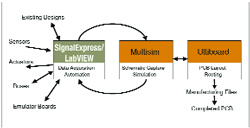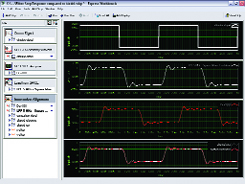Latest News
March 1, 2005
By Richard McDonell
Increasingly complex electronic board-level designs drive currentinnovation in electronic design automation (EDA) tools for circuitmodeling, layout, and simulation. Due to specific advances in SPICEmodeling and simulation capabilities, hardware design engineers cancomplete up to 90 percent of their designs in EDA software beforeproducing their first prototype. These cutting-edge tools assist designengineers in keeping up with the rising complexity of today’s designswhile maintaining or decreasing the lengths of their productdevelopment cycles.The
The Last 10 PercentDespite these improvements, most design engineers admit that while themodeling and simulation features found in the latest EDA tools savethem development time, they are still unwilling to sign off on acircuit design without verifying its performance in the lab.Ironically, continued innovation in EDA tools is causing a productivitygap between the design phase and age-old lab-based design verification.As a result, some engineers are spending more than 50 percent of theentire product development cycle performing iterative designverifications to complete the remaining 10 percent of their project.Some common manual tasks that hurt productivity in the lab includemeasurement setup, instrument configuration, data transfer, offlineanalysis, comparing simulated to actual results, swept measurements,and multidevice triggering and synchronization. Being able to reducetime spent on such tasks will produce a faster time to market.

New Era of EMA ToolsFigure 1: Engineers can capture real-world signals and use simulation waveformstodrive existing interfaces and verify that their designs work according to specifications.
Engineers can now use a variety of new verification tools, referred toas electronic measurement automation (EMA) tools, to streamline the labdesign verification process. These emerging EMA tools assist leadingelectronics manufacturers in closing the productivity gap betweendesign and verification by simultaneously automating time-consumingdesign verification tasks and maintaining the interactive nature ofusing stand-alone instruments to probe and scope measurements on, forexample, a circuit board. They do this by focusing on improving theintegration of desktop PCs, modular instrumentation, and interactivesoftware with the acquisition, comparison, analysis, and storage ofmeasurements.
Such integration means design engineers can more rapidly configureinstruments, acquire measurements, correlate live data with simulationresults, and file results for offline reporting and analysis. One suchtool, designed specifically for reducing lab time, is SignalExpressfrom National Instruments (NI).
NI SignalExpress is an interactive measurement environment in whichdesign engineers can quickly acquire, compare, automate, and storetheir benchtop measurements. The drag-and-drop nature of the softwarefor controlling modular and stand-alone benchtop instruments featuresmore than 75 built-in measurement and analysis functions for accessinglive verification measurements from a single user interface. It isintegrated with design and test tools such as Multisim from ElectronicsWorkbench and NI’s LabVIEW to facilitate thesharing of simulation and measurement data during verification andtesting. SignalExpress integration with LabVIEW also enables theconversion of SignalExpress projects to LabVIEW virtual instruments(VIs), reducing the amount of test software development required.
Closing the Design LoopHistorically, design engineers have simulated circuits with modelsbased on electrical and physical component characteristics. Thesesimulations, while powerful and helpful in the design and verificationprocess, are not without their limitations. Design engineers can nowuse Multisim and SignalExpress to close the electronic design andverification loop. This combination provides input and feedback neverbefore available in the design process, helping to more efficientlytest and verify both physical circuits and their simulations.
When engineers bridge the crossover point between hardware design andverification, which has traditionally been neglected, they can iteratemore tightly through the design process by identifying discrepanciesand addressing them in their prototypes. To do this, they need to beable to easily reuse and compare the signal data, simulated ormeasured, in either domain. Accurately modeling sensors and buses usingreal-world signals, for example, has been a difficult andtime-consuming process. But by capturing these signals and using themto drive simulations (see Figure 1, above), engineers can then usethe simulation waveforms to drive existing interfaces and verify thatthe design is working according to specifications. It would also beuseful to be able to directly compare simulation waveforms toreal-world waveforms to help tighten simulations and aid in debugging.

Figure 2: Importing a Multisimsimulation in NI SignalExpress for direct correlationbetween simulated and measured response signals.
PCB Design
Electronics Workbench develops EDA tools for all major steps in thecircuit design flow, including schematic capture, simulation, printedcircuit board (PCB) layout, autorouting, and CAM preparation. Circuitsimulators are powerful tools that use models to represent componentbehavior. Alone, they cannot capture or drive real-world signals, sodesigners need to use DA (data acquisition) and control devices andassociated application software to drive signals.
Bridging Design and VerificationBy combining the schematic capture, simulation, and analysis toolsavailable in Multisim and the DA and measurement features provided byNI’s measurement devices and SignalExpress software, design engineerscan sample real- world signals and incorporate them into simulations.They can then drive simulations with data acquired from the actualsensors, test points, or even data and address buses, in their design.
Engineers also benefit from importing simulation results from Multisiminto SignalExpress. Using SignalExpress, they can correlate simulationand actual measurement responses easily as well as drive externalcircuitry with the simulation results to significantly increaseefficiency in the design verification process.
Figure 2 (above) demonstrates how a design engineer can useSignalExpress to compare the time-domain step response of a low-passfilter with its simulation results. Here, the design engineer providesa 500kHz square wave (top signal) stimulus signal and illustrates howthe filter responds to the step input. The engineer then acquires thestimulus signal with a digitizer board and exports it to Multisim. FromMultisim, the exact physical stimulus signal is used to drive thesimulation as well. The simulated step response is then imported intoSignalExpress (second signal). The actual step response is measuredusing the digitizer (third signal). The simulated and actual stepresponse signals are then resampled and automatically aligned toquickly determine how closely the signals align (bottom signal).
Improved EDA and EMA product integration is bridging the connectivitygap between design and verification. These innovative tools are readilyavailable for electronics manufacturers to realize the benefits of ashortened product development cycle.
Editor’s Note: As this was going to press, National Instruments announced theacquisition ofElectronics Workbench.
Richard McDonell is a Senior Product Manager for NI SignalExpress andSoftware Group Manager at National Instruments. To comment on thisarticle, send an e-mail to [email protected].
Products Mentioned in this Article
SignalExpress
National Instruments
Austin, TX
Multisim
Electronics Workbench
Toronto, ONT
Subscribe to our FREE magazine, FREE email newsletters or both!
Latest News
About the Author
DE’s editors contribute news and new product announcements to Digital Engineering.
Press releases may be sent to them via [email protected].






